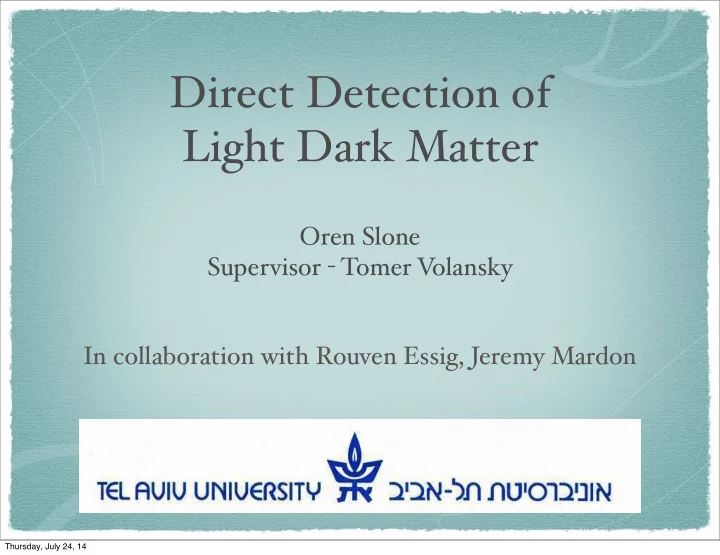

Direct Detection of Light Dark Matter Oren Slone Supervisor - Tomer V olansky In collaboration with Rouven Essig, Jeremy Mardon Thursday, July 24, 14
Motivation u n - e x p l o r e d Thursday, July 24, 14
New avenues for light DM direct detection Low Energy Threshold Systems Chemical Bond Creation of Breaking in Molecules Color Centers ~ few eV ~ few 10 eV m 1 m 1 m 2 q m 2 Thursday, July 24, 14
Molecular Detection Rate V elocity # of DM DM Target Distribution Targets Density Form Factor Form Factor Thursday, July 24, 14
The Molecular Form Factor WaveFunction Overlap for l = 90 0.6 0.4 Final State Initial State 0.2 W avefunction W avefunction 6 r @ a 0 D 2 3 4 5 - 0.2 - 0.4 The FF ~ The W avefunction Overlap Thursday, July 24, 14
Understanding the Rate Outgoing Free Classical Picture Radial Waves 20 eV Molecular Form Factor † F dis H q L§ 2 20 m 1 15 m 1 m 2 10 q m 2 5 q @ keV D 240 260 280 300 320 Thursday, July 24, 14
Expected Rates for H 2 Event Rate @ 100 kg yr D 10 8 10 7 10 6 Radial Waves Classical Picture 10 5 10 4 1000 10 4 M c @ MeV D 1 10 100 1000 Thursday, July 24, 14
Expected Sensitivity + Cross Section Sensitivity and Event Rate for H 2 H per 100kg year L 10 - 39 10 3 10 - 40 Event Rate H s p = 10 - 37 cm 2 L 10 4 10 - 41 10 5 s p @ cm 2 D 10 - 42 10 6 10 - 43 10 7 10 - 44 10 8 10 - 45 10 10 2 10 3 10 4 m c @ MeV ê c 2 D Thursday, July 24, 14
Future Prospects Understanding Color Centers Solar Neutrinos Experimental Setup Thursday, July 24, 14
Thank You Thursday, July 24, 14
Backup Thursday, July 24, 14
The True Interaction Rate Two Competing Effects Form Factor is suppressed because outgoing wavefunction has less overlap. Phase space grows because the momentum grows as the atom leaves the potential well. Thursday, July 24, 14
Backgrounds Use of annual modulation Slow neutrons: Understand the background from one area of the experiment and extrapolate. Use fiducial volume excluding the outskirts. Energetic neutrons: Remove high energy events. Neutrinos: Understand the Background Electrons / Gamma Rays: Problem for molecules No problem for color centers Thursday, July 24, 14
Other Experiments Detection Reported Energy Experiment Remarks Technique Signal Threshold Ionization and XENON 100 NO ~ 10 - 100 keV Scintillation Ionization and Currently most LUX NO ~ 10 keV Scintillation sensitive Scintillation YES Possibly due to muon DAMA/Libra NaI ( Annual Modulation ) flux CDMS Ionization and YES ( for Si ) Only a few events ~ 10 keV Phonons NO ( for Ge ) reported ( Si / Ge ) CoGeNT Ionization YES CRESST Phonon Detection YES Flouresence Molecules NOT YET ~ 10 - 100 eV Ion Drifting Polymerization Thursday, July 24, 14
Other Experiments Thursday, July 24, 14
Example Model for LDM Fermionic DM charged under a new U ( 1 ) D A D gauge boson with coupling g D Coupling to SM through kinetic mixing with the photon. Essig, Mardon, V olansky, arXiv: 1108:5383 Thursday, July 24, 14
Solar Neutrinos Thursday, July 24, 14
Oren Slone Supervisor - Dr. Tomer Volansky New direct detection techniques for light ( sub GeV ) DM Chemical bond breaking in molecules Color centers Experimental setup + Cross Section Sensitivity and Event Rate for H 2 H per 100kg year L Detection via photons / chemical amplification 10 - 38 10 2 Event Rate H s p = 10 - 37 cm 2 L Application to detection of solar 10 - 39 10 3 s p @ cm 2 D neutrinos 10 - 40 10 4 10 - 41 10 5 Dynamical RPV with new LHC 10 - 42 10 10 2 10 3 10 4 m c @ MeV ê c 2 D phenomenology Thursday, July 24, 14
Recommend
More recommend